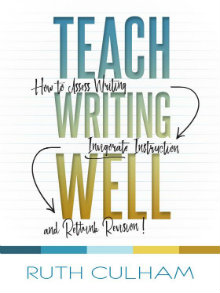Invigorating Our Teaching of Writing and Revision
Teach Writing Well: How to Assess Writing, Invigorate Instruction, and Rethink Revision
By Ruth Culham
(Stenhouse, 2018 – Learn more)

Ruth Culham’s Teach Writing Well: How to Assess Writing, Invigorate Instruction, and Rethink Revision made me want to become an even more active writing teacher, one who encourages students to “explore, talk, think, and question” (3) in order to write effectively.
Teach Writing Well is practical and goes step by step through incorporating writing traits into your classroom – but undergirding it is a sense of exuberance and discovery. As Culham says in the introduction, “Moving forward in writing instruction is a matter of welcoming wonder into your classroom” (5).

Fresh and Interactive
The design of Teach Writing Well feels like a process of discovery in itself. Unlike most pedagogy books, it is laid out in color, giving it a fresh and interactive feel.
The book’s power lies in a premise that links clear formative assessment to effective revision. Culham’s goal is “to demystify how to teach revision, which is arguably the trickiest part of being a writing teacher” (93). As she notes, we’ve all worked with writers who think that revision is simply editing, or who chafe at going back to a piece they believe is already “done” after one draft.
Understanding and Applying the 7 Traits
The book has two parts.
“Part I: Read the Writing” asks us to explore the seven traits of writing, each with four key qualities underneath, and consider how to use this list of twenty-eight for formative assessment.
The five traits related to revision are Ideas, Organization, Voice, Word Choice and Sentence Fluency, and the two traits related to editing are Conventions and Presentation. I found the key qualities under each trait extremely helpful in breaking down what is working and not working in a draft.
Culham also includes many ready-to-use student handouts describing the seven traits, as well as ample numbers of sample papers to show the traits in action.
The four chapter titles in Part I are:
Chapter 1: Thinking Back and Thinking Forward With the Traits of Writing
Chapter 2: Formative Assessment: The Heart of the Matter
Chapter 3: Modes of Writing: Their Challenges and Why They Matter
Chapter 4: Tools and Talk to Guide Revision
The modes of writing Culham addresses in Chapter 3 are narrative, persuasive, and expository, which she defines as “what we write and for whom,” versus the traits, which encompass how we write (55). For each mode, she gives a nice list of challenges by trait. For instance, for the Ideas trait in the persuasive mode, she argues that many students “haven’t learned that all facts are not created equal” (64).
In Chapter 4, Culham breaks teacher feedback into two intuitive categories:
- Over-the-Shoulder Comments (The Walk-By, the Stop and Go, and the Stop and Stay)
- Eye-to-Eye Conferences, which she considers sacred time with an individual student.
Read an Article by Ruth Culham here at MiddleWeb:
“Rethinking Revision: The Real Work of Writing”
Basing Revision on Formative Assessment
“Part 2: Teach the Writer” asks us to implement the assessment tools from Chapters 1-4 in the work of revision. I really enjoyed the specificity of this section, with teacher-ready tools such as:
“Squeeze it once and let it go”
With this reminder to simplify, Culham encourages us to “focus on one and only one key quality at a time” (101). For instance, if you are working with the key quality of “varying sentence patterns” under the Sentence Fluency trait, you can spend a week on this particular quality and then move on to another quality the next week.
Yes, you might not hit every concept all at once – but hitting everything all at once can be crazymaking, for both students and their teachers!
Throughout the book, Culham urges patience and calm. There’s a pervasive sense of waiting for students’ potential to reveal itself bit by bit, as when Culham observes, “Many students write to please the teacher, to get a good grade, or simply to be finished. These writers have yet to discover the power of voice” (61). I want to carry this hope of “not yet” into the classroom with me this year.
The Writing Wallet
Here is the physical manifestation of Culham’s work-in-progress philosophy: a folder with two to four pieces that could be “quick-writes, responses to literature, self-reflections at the start of writing activities, warm-ups, journal ideas, short answers to essays, or any other writing students do during the day. Each piece should be short (less than a page) and raw. No corrections or revisions should be evident – yet” (110).
When a teacher does a focus lesson on a key quality from a trait, students can pick a piece from the wallet on which to practice the quality, providing student choice and revision of real pieces. Teachers should also have several paragraph-length pieces in their own writing wallet that they can pull out and use in modeling revision.
Going Big: Spiraling Your Writing Curriculum
Culham is a compelling storyteller. Just after I finished her book, I found myself at lunch with a K-6 principal who was excited about a schoolwide initiative she was planning for the fall. I told her a story from the end of the book about the importance of spiraling curriculum from grade to grade.
A district Culham was working with found that, even with a K-8 writing curriculum that grew in difficulty and scope from year, “after several years of steady gains, the scores plateaued.” So she and the district tried an experiment, holding a professional development session with teacher representatives to read over nine anonymous lessons, one from each grade level, that covered “using details,” one of four key qualities under the Ideas trait.
The teachers ranked the nine lessons In terms of challenge. Their verdict? “The fifth-grade lesson was deemed the most difficult by the majority of the group. The second-grade lesson was ranked the easiest…. The group also considered three grades to have the same level of difficulty.” After the district made sure that the degree of difficulty increased each year, scores began rising again (125-6).
We’re in This Together
Culham ends her narrative with words of encouragement and collaboration: “No one can teach everything about writing in one year – this is a team sport.” Yet she goes on to emphasize how much each of us can accomplish, in small steps, throughout a year or more: “You can, however, make sure students gain knowledge and skill that builds successfully, one year upon the next, until what they know and can do will dazzle you” (169).
After reading Teaching Writing Well, I’m ready to roll up my sleeves and be dazzled!
________________
Sarah Cooper teaches eighth-grade U.S. history and is dean of studies at Flintridge Preparatory School in La Canada, California, where she has also taught English Language Arts. She is the author of Making History Mine (Stenhouse, 2009) and Creating Citizens: Teaching Civics and Current Events in the History Classroom (Routledge/MiddleWeb, 2017). She presents at conferences and writes for a variety of educational sites. You can find all of Sarah’s writing at sarahjcooper.com.


































